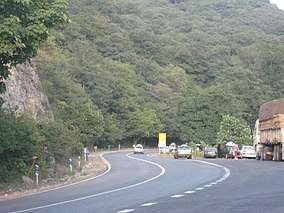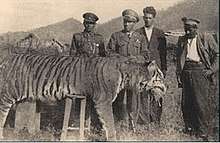Golestan National Park
Golestan National Park (Persian: پارک ملی گلستان), commonly known as the Golestan Jungle (جنگل گلستان), is an Iranian National Park in Golestan Province, northeastern Iran.
| Golestan National Park | |
|---|---|
IUCN category II (national park) | |
 | |
 Location in Iran | |
| Location | Iran |
| Coordinates | 37.547527°N 56.382423°E |
| Area | 918.9 km2 (354.8 sq mi) |
| Governing body | Department of the Environment |
Geography
The park is located in the eastern Alborz (Elburs) Mountains range and the western edge of the Kopet Dag range. It comprises 91,890 ha.[1] Elevations in the park range from 1,000–1,400 metres (3,300–4,600 ft) above sea level.
Ecology
Golestan National Park has a variety of habitats, such as temperate broad leaf forests, grasslands, shrublands and rocky areas.[2][3] The diverse flora includes stands of white Eremurus kopetdaghensis, Iris acutiloba subsp. lineolata and Iris kopetdagensis.[4]
The fauna is very rich and consists of Persian leopards (Panthera pardus ciscaucasica), Indian wolves (Canis lupus pallipes), brown bear (Ursus arctos), golden jackal (Canis aureus), wild boars (Sus scrofa), maral deer (Cervus elaphus maral), roe deer (Capreolus capreolus), urial (Ovis orientalis arkal), wild goats (Capra aegagrus) and goitered gazelles (Gazella subgutturosa).[5][6][7]
Extinct

Iran's last known tigers had occurred in this area, before 1960.[8][9][10]
See also
- Alborz (Elburz) mountain range topics
- Caspian Hyrcanian mixed forests
- List of national parks and protected areas of Iran
- Wildlife of Iran
References
- Iranian Tourism & Touring Online (ITTO)
- Nosrat Safaian, Maryam Shokri, Mikhalegh Ziatabar Ahmadi, Abdolnaser Atrakchali, Ali Tavili: Fire Influence on the Grassland Vegetation in Golestan National Park (Alborz Mts. iran) Polish Journal of Ecology. 53 1 435–443. 2005 "Archived copy" (PDF). Archived from the original (PDF) on 2011-12-13. Retrieved 2012-10-06.CS1 maint: archived copy as title (link) [online-PDF]
- UNESCO – World Heritage; Ref.5213
- Basak Gardner & Chris Gardner Flora of the Silk Road: The Complete Illustrated Guide, p. 173, at Google Books
- Waraste, Moradi H.: Population Dynamism of the Bovidae in Golestan National Park. Journal of Agricultural Sciences and Natural Resources Fall 2004; 11(3):163–172
- Waraste, Moradi H.: Determination of Sex Ratio and Age Groups in Two Species Cervus Elaphus and Capreolus in Golestan National Park Journal of Agricultural Sciences and Natural Resources. October–November 2005; 12(4):154–161.
- Meigouni, H.G., Jahanshahi, M.; Kavoosi, K.; Kiabi B.H.: A Study on Herbivorous Habits of Wild Pig (Sus Scrofa) In Golestand National Park. Journal of Environmental Studies. March 2003; 28(30):55−64.
- Geptner, V. G., Sludskij, A. A. (1972). Mlekopitajuščie Sovetskogo Soiuza. Vysšaia Škola, Moskva. (In Russian; English translation: Heptner, V.G., Sludskii, A. A., Komarov, A., Komorov, N.; Hoffmann, R. S. (1992). Mammals of the Soviet Union. Vol III: Carnivores (Feloidea). Smithsonian Institution and the National Science Foundation, Washington DC).
- Humphreys, P., Kahrom, E. (1999). Lion and Gazelle: The Mammals and Birds of Iran. Images Publishing, Avon.
- Firouz, E. (2005). The complete fauna of Iran. I. B. Tauris. pp. 66–67. ISBN 978-1-85043-946-2.
External links
| Wikimedia Commons has media related to Golestan National Park. |